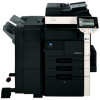Konica Minolta bizhub 501 bizhub 361/421/501 Fax Driver Operations User Manual - Page 24
For Windows NT 4.0, select LPR Port in the Available Printer Ports list, and then click the [New
 |
View all Konica Minolta bizhub 501 manuals
Add to My Manuals
Save this manual to your list of manuals |
Page 24 highlights
Installing the fax driver 2 5 In the screen for selecting the printer connection, select "Local Printer". 6 Click the [Next] button. A screen for specifying ports appears. 7 Click "Create a new port", and then select "Standard TCP/IP Port" for the type of port. - For Windows NT 4.0, select "LPR Port" in the "Available Printer Ports" list, and then click the [New Port] button. For details, refer to the User's Guide [Print Operations (IC-207)]. 8 Click the [Next] button. The Add Standard TCP/IP Printer Port Wizard starts. 9 Click the [Next] button. 10 In the "Printer Name or IP Address" box, enter the IP address for this machine, and then click the [Next] button. - If the Additional Port Information Required dialog box appears, go to step 11. - If the Finish screen appears, go to step 14. 11 Select "Custom", and then click the [Settings] button. 12 Change the settings according to the port, and then click the [OK] button. - For an LPR connection, Select "LPR", and then enter "Print" in the "Queue name" box. - For a Port9100 connection, select "RAW", and then enter the RAW port number (9100 at default) in the "Port Number" box. - The information entered here is case-sensitive. 13 Click the [Next] button. 14 Click the [Finish] button. The Add Printer Wizard appears. 15 Click the [Have Disk] button. 16 Click the [Browse] button. 17 Specify the desired folder on the CD-ROM that contains the fax driver, and then click the [Open] button. - Select the specified folder according to the printer driver to be used, the operating system, and the language. 18 Click the [OK] button. The "Printers" list appears. Fax Driver 2-13















